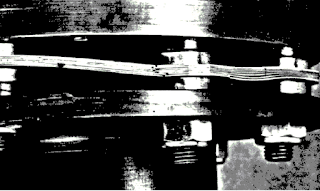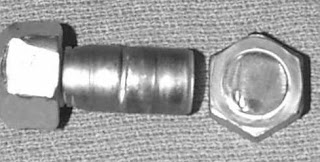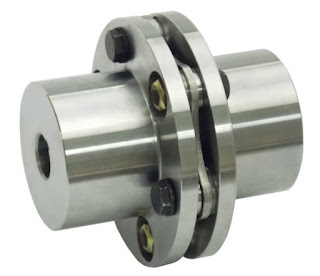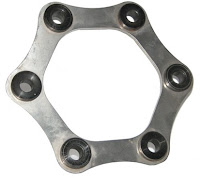To date, the Coupling Answers blog posts coupling failures (including Jaw Coupling Failure Analysis , Gear Coupling Failure Analysis, and Grid Coupling Failure Analysis) have been extremely well-received and appreciated by our amazing customer base. One of the reasons these posts have been so well received is that so few people like to talk about failures. Fortunately, we at Lovejoy, are confident enough in our products, design capabilities, and general understanding of power transmission that troubleshooting isn't something we shy away from. (In fact, for Hannover Fair 2015, we actually hosted a Coupling Solutions Learning Lab that was loaded with actual failed couplings. This caught countless German engineers completely off-guard.) Moving on...
Misalignment Failures
 |
| Misalignment Failure |
 |
| Misalignment Failure |
If misalignment is the likely source of a disc pack failure, it is important to realign the coupling prior to restarting the system, less the issue repeat itself. (Two options to consider when realigning a coupling are laser alignment and dial indicators.) An additional step you can take if you are not using a scalloped disc pack by Lovejoy (which offers increased misalignment handling over legacy designs), you can source a replacement coupling from us!
 |
| Misalignment Failure |
Torque Overload Failures
 |
| Disc Pack Torque Overload Failure |
Torque overload failures in disc packs look different from misalignment failures in that the fatigue cracks tend to form in the center of the disc pack rather than up against the bushings (as pictured at right).
A second thing to look for when suspecting torque overload on this disc pack is any evidence that the disc pack layers (or laminates) are separating or ballooning away from each other in the center sections between bushings.
 |
| Bent Disc Pack Bolts |
 |
| Disc Coupling Hub Burst |
Installation & Fastener Failures
One of the fastest way to damage a disc coupling during installation is to use impact wrenches. (Do not do this!) Not only does using an impact wrench raise the potential of twisting the disc pack (pictured at right) in a destructive manner, but it also raises the possibility of friction welding the fastener bolts to either the disc pack and or the connected flange. Fasteners should be lubricated prior to installation and torqued with care.
On the other end of the spectrum, improper torque of the fasteners may cause them to loosen. This loosening can then lead to damage and wear to the fasteners as well as hole elongation and cracking of the disc packs. To avoid either over or under torquing the fasteners, be sure to read and follow the disc coupling's installation instructions. (Lovejoy's disc coupling installation instructions and videos can be found here.)
Environmental Failures
 While disc couplings generally hold up very well to many environmental conditions, they are certainly not impervious to everything. As such, it is critical that coupling users understand what corrosive agents may be present for a given application, and that the disc coupling is designed to operate under those conditions. (Pictured at right is a circular, non-scalloped, disc pack layer that has been corroded.)
While disc couplings generally hold up very well to many environmental conditions, they are certainly not impervious to everything. As such, it is critical that coupling users understand what corrosive agents may be present for a given application, and that the disc coupling is designed to operate under those conditions. (Pictured at right is a circular, non-scalloped, disc pack layer that has been corroded.) Life Expectancy
Having just covered misalignment, torque overload, installation, fastener, and environmental failures of disc couplings, a natural question might be "How long is my coupling going to last?" Unfortunately, like all other coupling type, disc coupling life is not generically predictable as it is highly dependent upon the application and the misalignment of the given system it is driving. Shaft alignment does correlate strongly with longer coupling life... so taking the time to align the system properly with periodic checks should pay lasting dividends and not be overlooked.
To learn more about Lovejoy's disc coupling solutions for your applications, please check out Lovejoy's disc coupling product pages & catalogs, the non-lubricated section of The Coupling Handbook, and/or pick up the phone ask to speak with a Lovejoy application specialist.





















